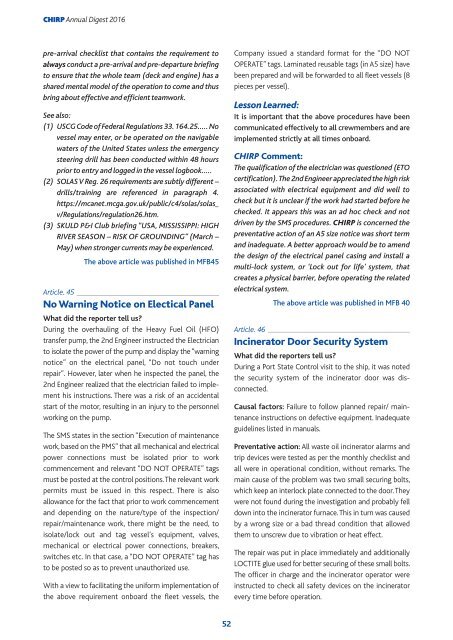CHIRP annual digest 2016 6th
You also want an ePaper? Increase the reach of your titles
YUMPU automatically turns print PDFs into web optimized ePapers that Google loves.
<strong>CHIRP</strong> Annual Digest <strong>2016</strong><br />
pre-arrival checklist that contains the requirement to<br />
always conduct a pre-arrival and pre-departure briefing<br />
to ensure that the whole team (deck and engine) has a<br />
shared mental model of the operation to come and thus<br />
bring about effective and efficient teamwork.<br />
See also:<br />
(1) USCG Code of Federal Regulations 33. 164.25….. No<br />
vessel may enter, or be operated on the navigable<br />
waters of the United States unless the emergency<br />
steering drill has been conducted within 48 hours<br />
prior to entry and logged in the vessel logbook…..<br />
(2) SOLAS V Reg. 26 requirements are subtly different –<br />
drills/training are referenced in paragraph 4.<br />
https://mcanet.mcga.gov.uk/public/c4/solas/solas_<br />
v/Regulations/regulation26.htm.<br />
(3) SKULD P&I Club briefing “USA, MISSISSIPPI: HIGH<br />
RIVER SEASON – RISK OF GROUNDING” (March –<br />
May) when stronger currents may be experienced.<br />
The above article was published in MFB45<br />
Article. 45<br />
No Warning Notice on Electical Panel<br />
What did the reporter tell us?<br />
During the overhauling of the Heavy Fuel Oil (HFO)<br />
transfer pump, the 2nd Engineer instructed the Electrician<br />
to isolate the power of the pump and display the “warning<br />
notice” on the electrical panel, “Do not touch under<br />
repair”. However, later when he inspected the panel, the<br />
2nd Engineer realized that the electrician failed to imple -<br />
ment his instructions. There was a risk of an accidental<br />
start of the motor, resulting in an injury to the personnel<br />
working on the pump.<br />
The SMS states in the section “Execution of maintenance<br />
work, based on the PMS” that all mechanical and electrical<br />
power connections must be isolated prior to work<br />
commencement and relevant “DO NOT OPERATE” tags<br />
must be posted at the control positions. The relevant work<br />
permits must be issued in this respect. There is also<br />
allowance for the fact that prior to work commencement<br />
and depending on the nature/type of the inspection/<br />
repair/maintenance work, there might be the need, to<br />
isolate/lock out and tag vessel’s equipment, valves,<br />
mechanical or electrical power connections, breakers,<br />
switches etc. In that case, a “DO NOT OPERATE” tag has<br />
to be posted so as to prevent unauthorized use.<br />
With a view to facilitating the uniform implementation of<br />
the above requirement onboard the fleet vessels, the<br />
Company issued a standard format for the “DO NOT<br />
OPERATE” tags. Laminated reusable tags (in A5 size) have<br />
been prepared and will be forwarded to all fleet vessels (8<br />
pieces per vessel).<br />
Lesson Learned:<br />
It is important that the above procedures have been<br />
communicated effectively to all crewmembers and are<br />
implemented strictly at all times onboard.<br />
<strong>CHIRP</strong> Comment:<br />
The qualification of the electrician was questioned (ETO<br />
certification). The 2nd Engineer appreciated the high risk<br />
associated with electrical equipment and did well to<br />
check but it is unclear if the work had started before he<br />
checked. It appears this was an ad hoc check and not<br />
driven by the SMS procedures. <strong>CHIRP</strong> is concerned the<br />
preventative action of an A5 size notice was short term<br />
and inadequate. A better approach would be to amend<br />
the design of the electrical panel casing and install a<br />
multi-lock system, or ‘Lock out for life’ system, that<br />
creates a physical barrier, before operating the related<br />
electrical system.<br />
The above article was published in MFB 40<br />
Article. 46<br />
Incinerator Door Security System<br />
What did the reporters tell us?<br />
During a Port State Control visit to the ship, it was noted<br />
the security system of the incinerator door was dis -<br />
connected.<br />
Causal factors: Failure to follow planned repair/ main -<br />
tenance instructions on defective equipment. Inadequate<br />
guidelines listed in manuals.<br />
Preventative action: All waste oil incinerator alarms and<br />
trip devices were tested as per the monthly checklist and<br />
all were in operational condition, without remarks. The<br />
main cause of the problem was two small securing bolts,<br />
which keep an interlock plate connected to the door. They<br />
were not found during the investigation and probably fell<br />
down into the incinerator furnace. This in turn was caused<br />
by a wrong size or a bad thread condition that allowed<br />
them to unscrew due to vibration or heat effect.<br />
The repair was put in place immediately and additionally<br />
LOCTITE glue used for better securing of these small bolts.<br />
The officer in charge and the incinerator operator were<br />
instructed to check all safety devices on the incinerator<br />
every time before operation.<br />
52



